Naan bread is my favorite kind of bread. In most Indian restaurants, you can choose between naan bread and rice in lunch sets and dinner courses. I choose naan bread in most cases, because freshly baked bread is always appealing, especially when I can see how it is made in the kitchen. The rice in KUMAR is saffron rice. Obviously, it is vegan, however, I have never tried it.
Finally, I had chai. I have had chai not only in KUMAR but also in several Indian restaurants including those in big cities like Nagoya and Osaka. But chai in KUMAR is the best one I know. It has a robust flavor that I can’t explain well. Compared with it, chai in other restaurants felt tasteless or watery. Maybe they used much more milk because the color was paler. Personally, I prefer stronger taste. The drink options also include coffee, iced tea, orange juice, and oolong tea.
In KUMAR, you can enjoy the atmosphere of India just by looking around. There are many objects from India used for decoration or sold. One of them is a very fine sculpture on the wall.
There were also Buddhist images. Seeing their expressions, I remembered the series of comic books “Buddha” by Osamu Tezuka, which depicts hardships the hero Siddhartha had to undergo before he became Buddha.
This display was colorful mixture of different religions. Beside Indian gods and Buddha, there was a little Christmas tree, which was amusing to see and created a festive atmosphere. Today is the last day of November, and Christmas is coming soon.
KUMAR
Address: Act Plaza B1, 111-2 Itaya-machi, Naka-ku, Hamamatsu-shi, Shizuoka
Tel: 053-451-0154
Open hours: Mon.-Fri. Lunch: 11:00-15:00 (LO 14:30)
Dinner: 17:00-23:00 (LO 22:00)
Sat., Sun., national holidays
11:00-23:00 (LO 22:00)
Access: 5-minute walk from JR Hamamatsu Station

















































